Volume of a Prism
The volume of a prism is the amount of space taken up by that prism. The
general formula for calculating the volume of a prism is very simple:
Volume = B
h
where B is the area of the base, and h is the prism’s height. Certain
geometric solids have slightly different formulas for calculating volume that we
will cover on a case-by-case basis.
Surface Area
The surface area of a prism is the sum of the areas of all the prism’s
sides. The formula for the surface area of a prism therefore depends on the type
of prism with which you are dealing. As with volume, we cover the specifics of
calculating surface area as we cover each type of geometric solid.
Rectangular Solids
A rectangular solid is a prism with a rectangular base and lateral edges
that are perpendicular to its base. In short, a rectangular solid is shaped like
a box.
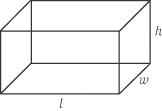
A rectangular solid has three important dimensions: length (l, width (w), and height (h). If you know these measurements,
you can find the solid’s surface area, volume, and diagonal length.
Volume of a Rectangular Solid
The volume of a rectangular solid is given by the following formula:
Volume =
lwh
where l is the length, w is the width, and h is the height.
Notice how this formula corresponds with the general formula for the volume of a
prism: the product lw is the area of the base. Now try to find the volume of the prism in the following example:
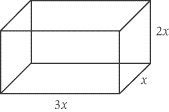
In this solid, l = 3x,w = x, and
h = 2x. Simply plug the values into the formula given for volume, and you would find
Volume = (3x)(2x)(x) = 6x3.
Surface Area
The surface area of a rectangular solid is given by the following formula:
Surface Area = 2
lw +2
lh+ 2
wh
where l is the length, w is the width, and h is the height.

The six faces of a rectangular solid consist of three congruent pairs. The
surface area formula is derived by simply adding the areas of the faces—two
faces have areas of l × w, two faces have areas of l
× h, and two faces have areas of w × h.
To practice, try to find the surface area of the rectangular solid we used as an
example for volume. Here’s the figure again:

All you have to do is enter the given values into the formula for surface area:

Diagonal Length of a Rectangular Solid
The diagonal of a rectangular solid, d,
is the line segment whose endpoints are opposite corners of the solid. Every
rectangular solid has four diagonals, each with the same length, that connect
each pair of opposite vertices. Here’s one diagonal drawn in:
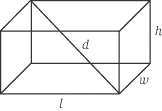
The formula for the length of a diagonal is:

where l is the length,
w is the width, and
h is the height.
You can look at this formula as the Pythagorean theorem in three dimensions. In
fact, you can derive this formula using the Pythagorean theorem. First, find the
length of the diagonal along the base. This is

.
Then use the Pythagorean theorem again, incorporating height to find the length
of the diagonal from one corner to the other:

Thus,

and

A Math IC question might ask you:
What is the length of diagonal AH in the rectangular solid below if AC
= 5, GH = 6, and CG = 3?
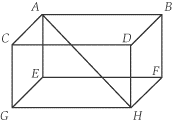
The question gives the length, width, and height of the rectangular solid, so
you can just plug those numbers into the formula:

The length of the diagonal
AH (as well as
BG,
CF, and
DE)
is v7.
Cubes
Just as a square is a special kind of rectangle, a cube is a special kind of
rectangular solid. A cube is a rectangular solid whose edges are each the
same length. In other words, the length, width, and height are equal, and each
of its six faces is a square.

Volume of a Cube
The formula for finding the volume of a cube is essentially the same as the
formula for the volume of a rectangular volume. However, since a cube’s length,
width, and height are all equal, the cube volume formula is:
Volume of a Cube = 8
3
where
s is the length of one edge of the cube.
Surface Area of a Cube
Since a cube is just a rectangular solid whose sides are all equal, the formula
for finding the surface area of a cube is the same as that for a rectangular
solid, except with s = l = w = h:
Surface Area of a Cube = 6
82
where
s is the length of one edge of the cube.
Diagonal Length of a Cube
The same is true for measuring the diagonal length of a cube. The formula for
the diagonal of a cube is simply adapted from the formula for the diagonal
length of a rectangular solid, with s = l = w = h:

where
s is the length of one edge of the cube.
Cylinders
A
cylinder is a prism with circular bases.

The height of a cylinder, h, is the length of the line segment whose
endpoints are the centers of the bases. The radius of a cylinder, r, is
the radius of its base. If you know the height and radius of a cylinder, you can
easily calculate its volume and surface area.
Volume of a Cylinder
The volume of a cylinder is the product of the area of its base and its height.
Because a cylinder has a circular base, the volume of a cylinder is:
Volume of a Cylinder = pr
2h
where r is the radius of the circular base and h is the height.
Try to find the volume of the cylinder below:
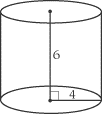
This cylinder has a radius of 4 and a height of 6. Using the volume formula:
Volume = p(4)
2 (6) = 96p
Surface Area of a Cylinder
The surface area of a cylinder is the sum of the areas of the two bases and the
lateral face of the cylinder. The bases are congruent circles, so their areas
can be found easily. The lateral face is the tubing that connects the two bases.
When “unrolled,” the lateral base is simply a rectangle whose length is the
circumference of the base and whose width is the height of the cylinder.
Therefore, the surface area of a cylinder is given by this formula:
Surface Area = 2pr
2 + 2prh
where r is the radius and h is the height. As with finding the
volume of a cylinder, finding the surface area involves plugging the height and
radius of the base into the formula. To find the surface area of the cylinder in
the practice example on volume,

just plug the values into the formula:
Surface Area = 2p(4)
2 + 2p(4)(6)
= 32p + 48p
= 80 p
Back
Next
Next to display next topic in the chapter.
Mathematics Practice Questions
Video Lessons and 10 Fully Explained Grand Tests
Large number of solved practice MCQ with explanations. Video Lessons and 10 Fully explained Grand/Full Tests.